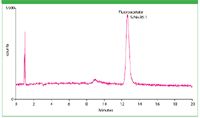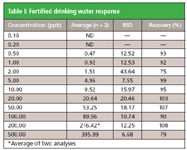Direct Determination of Fluoroacetate in Water by IC-MS
Fluoroacetate (Compound 1080) is a strong metabolic poison commonly used as a rodenticide and predacide (1). Due to the high level of toxicity when ingested (2), and no known antidotes, its use has been banned or restricted in many countries.
Fluoroacetate (Compound 1080) is a strong metabolic poison commonly used as a rodenticide and predacide (1). Due to the high level of toxicity when ingested (2), and no known antidotes, its use has been banned or restricted in many countries. The United States Environmental Protection Agency (US EPA) has placed sodium fluoroacetate in Toxicity Category I indicating the highest degree for acute oral toxicity. This study undertook an investigation to quantify fluoroacetate without prior derivatization or sample pretreatment. Use of an ion chromatographic (IC) separation with selected ion monitoring (SIM) mass spectrometric (MS) detection affords the opportunity to reliably identify this compound at trace levels in water samples.
Analysis
The experiment was performed using a Thermo Fisher Scientific Dionex ICS-3000 RFIC™ system with a Thermo Fisher Scientific Dionex IonPac™ AS-24 high-capacity column. The column was operated at 15 °C at 0.25 mL/min flow rate. An eluent generator provided isocratic 5 mM potassium hydroxide strength for elution of the target analyte and 80 mM to wash matrix off the column after each analysis. A fortified drinking water matrix was spiked to demonstrate the chromatographic separation and robustness of the method.
The Thermo Fisher Scientific MSQ Plus mass spectrometer was operated in SIM mode and utilized an electrospray ionization (ESI) spray source to introduce the IC effluent. The addition of 0.1 mL/min of acetonitrile to the flow by an AXP-MS auxiliary pump aided desolvation/ionization efficiency.
Results
As seen in Figure 1, fluoroacetate was chromatographically retained on the column and then detected by the MSQ Plus system at extremely low ppb levels. When challenged with a synthetic fortified water matrix, the analysis demonstrated excellent recovery and robustness across a wide range of concentrations (Table I).

Figure 1: SIM chromatogram of -77 m/z fluoroacetate at 2 ppb in DI water.
The use of the MSQ Plus provided molecular ion analyte selectivity and the use of the SIM function achieved low ppb levels of quantification with minimal sample preparation. Matrix effects and recovery were evaluated using a fortified water matrix and results show good precision and reproducibility.

Table I: Fortified drinking water response
For chromatography parameters and mass spectrometer conditions, refer to Dionex Production Application Note 276.1 (3).
References
(1) E.R. Kalmbach, Science 102 2644), 232–233 (1945).
(2) A.T. Proudfoot, S.M. Bradberry, and J.A. Vale, Toxicol. Rev. 25(4), 213–219 (2006).
(3) Dionex Corporation, "Direct Determination of Fluoroacetate in Water by IC-MS," Application Note 276, LPN 2807: Sunnyvale, CA.
All trademarks and registered trademarks belong to Thermo Fisher Scientific Inc. and its subsidiaries.
Dionex, now part of Thermo Fisher Scientific
1228 Titan Way, P.O. Box 3603, Sunnyvale, CA 94088
tel. (408) 737-0700, fax (408) 730-9403
Website: www.thermoscientific.com/dionex

Separation of Ultra-Short and Long Chain PFAS Compounds Using a Positive Charge Surface Column
December 11th 2024A separation of ultra-short and long chain PFAS (C1-C18) is performed on a HALO®PCS Phenyl-Hexyl column along with a HALO®PFAS Delay column which demonstrates excellent retention for both hydrophilic and hydrophobic analytes.

.png&w=3840&q=75)

.png&w=3840&q=75)



.png&w=3840&q=75)



.png&w=3840&q=75)














